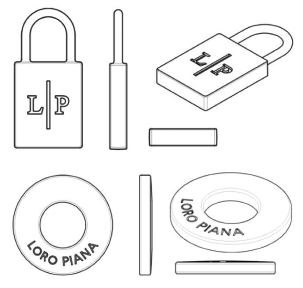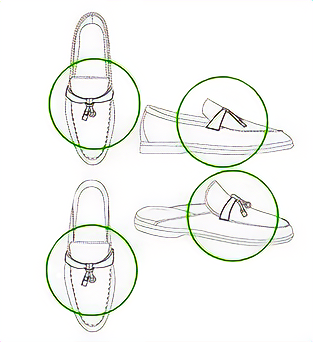Charming! LORO PIANA fails in EU position mark application
The failed LORO PIANA application for a position mark for footwear demonstrates how consumer expectations and the norms of the market influence the test of distinctiveness.
pia-pia-PIANA
LORO PIANA is an Italian luxury brand. Those who know, know, supposedly, and that is why LORO PIANA goes big on subtlety and small on branding.
For those who don’t know, some kind of distinguishing feature that sets the brand apart may be useful! Fortunately, LORO PIANA incorporates “charms” into some of its products as a distinguishing feature. These charms are in the form of a padlock and a ring and, when sold to customers, have the famous LORO PIANA branding engraved on them.

Keeping it plain: position mark applications
LORO PIANA uses these charms on its luxury footwear range. To protect the use of these charms, LORO PIANA applied to register a position mark in the EU.
A position mark is a type of trade mark right that protects specific and distinctive elements that are placed consistently on a specific area of a product.
For LORO PIANA the specific and distinctive elements were the charms (the padlock and ring), and the consistent placement of those elements was “closer to the tongue than to the toe of the shoe”. This is shown below (highlights added).

Importantly, however, the charms in the position mark application were plain (they did not contain the LORO PIANA branding) and there was no claim to the LORO PIANA branding in the description for the position mark.
Position marks: same but different?
The test for whether a trade mark is distinctive is, on paper, the same across all trade mark categories: a word mark, a figurative mark or a more esoteric trade mark category such as a position mark. However, what is different is that the public generally recognises that word marks (a brand name), and figurative marks (a logo) can be relied on to show that that a particular product comes from a particular company.
There is much less recognition amongst the public that a position mark (such as the placement of a plain padlock and plain ring closer to the tongue than to the toe of the shoe) can also have that function, particularly in the absence of words and/or logos. In order for a position mark to overcome the distinctiveness hurdle it needs to deviate significantly from the customs and norms of the sector, or have high consumer recognition through advertising and sales, such that consumers recognise that feature (without the addition of words/logos) as showing a particular product comes from a particular company.
Hurdle too high for LORO PIANA
The position mark application was rejected by the EUIPO on the basis that it was decorative and non-distinctive. Consumers would not recognise that shoes with a plain padlock and plain ring placed closer to the tongue than to the toe of a shoe were LORO PIANA shoes.
Other factors played into the failure of the LORO PIANA position mark application:
- The shoe market is saturated with decorative elements, and so the placement of the plain charms did not deviate significantly from the customs and norms of the sector.
- LORO PIANA could not show, via sales or other market indicators, that the placement of the charms, absent the LORO PIANA branding, was recognised by consumers (that it had inherent or acquired distinctiveness).
- Even if use of charms is a known practice in the luxury shoe market and consumers in that sector have a high degree of attention to these types of features, the charms were still decorative and non-distinctive.
- The existence of counterfeiters using the features of the position mark again pointed to the charms being decorative rather than distinctive.
In short
Are position marks possible? It is not impossible to register position marks. We have been successful in registering position marks for clients in jurisdictions around the world. However, as this case shows, a lot obviously depends on the design of the mark itself and the market concerned.
Case details at a glance
Jurisdiction: European Union
Decision level: EUIPO
Applicant: Loro Piana SpA
Case number: 018895734
Date: 26 April 2024